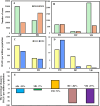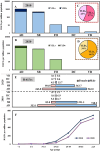Burden changes in notifiable infectious diseases in Taiwan during the COVID-19 pandemic
- PMID: 39267943
- PMCID: PMC11391939
- DOI: 10.7717/peerj.18048
Burden changes in notifiable infectious diseases in Taiwan during the COVID-19 pandemic
Abstract
Background: This study aimed to assess the impact of the COVID-19 pandemic on the disease burden of Taiwan's notifiable infectious diseases (NIDs). We compared disease burdens between the pandemic and pre-pandemic year of 2020 (with non-pharmaceutical interventions (NPIs)) and 2010 (without NPIs), respectively, to understand the overall pandemic impact on NIDs in Taiwan.
Methods: Forty-three national NIDs were analyzed using the Statistics of Communicable Diseases and Surveillance Report by estimating the premature death and disability via different transmission categories, sex, and age groups. The study evaluated the impact of diseases by assessing the years lost due to death (YLLs), the duration of living with disability (YLDs), and the overall disability-adjusted life years (DALYs) by measuring both the severity of the illness and its duration.
Results: Taiwan recorded 1,577 (2010) and 1,260 (2020) DALYs per million population and lost 43 NIDs, decreasing 317 DALYs per million population. Tuberculosis, HIV/AIDS and acute hepatitis B/D were the leading causes of DALYs, accounting for 89% (2010) and 77% (2020).
Conclusion: Overall, this study provided the first insight of changes in disease burdens in NIDs between pre- and post-COVID-19 based on a nationwide viewpoint for further preventive measures and interventions to be focused on specific diseases by associated health administrations and policies.
Keywords: Disease burden; Non-pharmaceutical interventions (NPIs); Notifiable infectious diseases (NIDs); Public health; SARS-CoV-2.
© 2024 Yang et al.
Conflict of interest statement
The authors declare that they have no competing interests.
Figures




Similar articles
-
Disease burden due to COVID-19 in Taiwan: Disability-adjusted life years (DALYs) with implication of Monte Carlo simulations.J Infect Public Health. 2023 Jun;16(6):884-892. doi: 10.1016/j.jiph.2023.03.028. Epub 2023 Mar 29. J Infect Public Health. 2023. PMID: 37058869 Free PMC article.
-
The impact of COVID-19 on the epidemiology of non-airborne/droplet-transmitted notifiable infectious diseases in Taiwan: A descriptive study.J Infect Public Health. 2022 Sep;15(9):1001-1005. doi: 10.1016/j.jiph.2022.08.001. Epub 2022 Aug 4. J Infect Public Health. 2022. PMID: 35981407 Free PMC article.
-
Interrupted time series analysis to evaluate the impact of COVID-19-pandemic on the incidence of notifiable infectious diseases in the Lazio region, Italy.BMC Public Health. 2025 Jan 13;25(1):132. doi: 10.1186/s12889-024-21256-4. BMC Public Health. 2025. PMID: 39806341 Free PMC article.
-
Global, regional, and national burden of 12 mental disorders in 204 countries and territories, 1990-2019: a systematic analysis for the Global Burden of Disease Study 2019.Lancet Psychiatry. 2022 Feb;9(2):137-150. doi: 10.1016/S2215-0366(21)00395-3. Epub 2022 Jan 10. Lancet Psychiatry. 2022. PMID: 35026139 Free PMC article.
-
Global burden of disease attributable to mental and substance use disorders: findings from the Global Burden of Disease Study 2010.Lancet. 2013 Nov 9;382(9904):1575-86. doi: 10.1016/S0140-6736(13)61611-6. Epub 2013 Aug 29. Lancet. 2013. PMID: 23993280 Review.
References
-
- Baker RE, Saad-Roy CM, Park SW, Farrar J, Metcalf CJE, Grenfell BT. Long-term benefits of nonpharmaceutical interventions for endemic infections are shaped by respiratory pathogen dynamics. Proceedings of the National Academy of Sciences of the United States of America. 2022;119(49):e2208895119. doi: 10.1073/pnas.2208895119. - DOI - PMC - PubMed
-
- Chen AP, Chu IY, Yeh ML, Chen YY, Lee CL, Lin HH, Chan YJ, Chen HP. Differentiating impacts of non-pharmaceutical interventions on non-coronavirus disease-2019 respiratory viral infections: hospital-based retrospective observational study in Taiwan. Influenza and Other Respiratory Viruses. 2021;15(4):478–487. doi: 10.1111/irv.12858. - DOI - PMC - PubMed
-
- Chen L, Wang L, Xing Y, Xie J, Su B, Geng M, Ren X, Zhang Y, Liu J, Ma T, Chen M, Miller JE, Dong Y, Song Y, Ma J, Sawyer S. Persistence and variation of the indirect effects of COVID-19 restrictions on the spectrum of notifiable infectious diseases in china: analysis of national surveillance among children and adolescents from 2018 to 2021. JMIR Public Health and Surveillance. 2024;10:e47626. doi: 10.2196/47626. - DOI - PMC - PubMed
Further Reading
-
- Birnie E, Virk HS, Savelkoel J, Spijker R, Bertherat E, Dance DAB, Limmathurotsakul D, Devleesschauwer B, Haagsma JA, Wiersinga WJ. Global burden of melioidosis in 2015: a systematic review and data synthesis. The Lancet Infectious Diseases. 2019;19(8):892–902. doi: 10.1016/S1473-3099(19)30157-4. - DOI - PMC - PubMed
-
- Cassini A, Colzani E, Pini A, Mangen MJ, Plass D, McDonald SA, Maringhini G, van Lier A, Haagsma JA, Havelaar AH, Kramarz P, Kretzschmar ME. Impact of infectious diseases on population health using incidence-based disability-adjusted life years (DALYs): results from the Burden of Communicable Diseases in Europe study, European Union and European Economic Area countries, 2009 to 2013. Eurosurveillance. 2018;23(16):17–00454. doi: 10.2807/1560-7917.ES.2018.23.16.17-00454. - DOI - PMC - PubMed
MeSH terms
LinkOut - more resources
Full Text Sources
Medical
Miscellaneous

